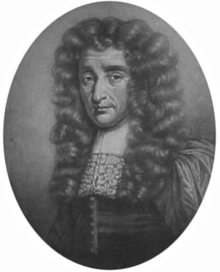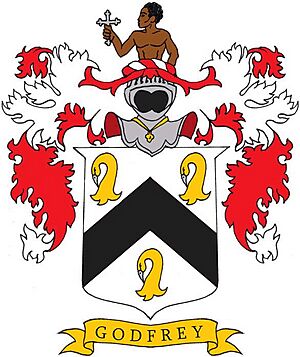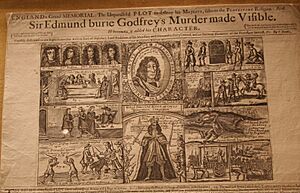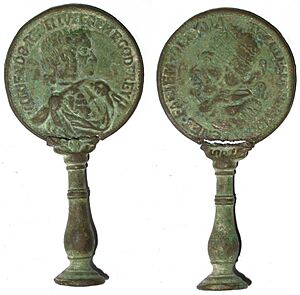Edmund Berry Godfrey facts for kids
Quick facts for kids
Edmund Godfrey
|
|
|---|---|
 |
|
| Born |
Edmund Berry Godfrey
23 December 1621 Sellindge, Kent
|
| Died | 12 October 1678 (aged 56) |
| Body discovered | Primrose Hill, London |
| Nationality | English |
| Other names | Edmundbury Godfrey |
| Education | |
| Parents |
|
Sir Edmund Berry Godfrey (born 23 December 1621 – died 12 October 1678) was an English official called a magistrate. His mysterious death caused a lot of anger against Catholics in England. Some old papers also spell his name Edmundbury Godfrey.
Contents
A Look at His Early Life
Edmund Berry Godfrey was born in Sellindge, Kent, a place between Hythe and Ashford. He was one of eighteen children! His father, Thomas Godfrey, came from an old family in Kent.
School Days and Career
Edmund went to Westminster School and then to Christ Church, Oxford university. After his studies, he became a successful wood and coal merchant. He also became a justice of the peace for Westminster. This meant he was a local judge who helped keep the peace.
In September 1666, he was made a knight by the King. He earned this honor because he stayed in his job during the terrible Great Plague of 1665. He helped people even when it was dangerous.
A Brave and Friendly Man
Sir Edmund was known for being a bit unusual. He liked to spend time with everyday people, not just those from his own social class. He also had important friends, like Gilbert Burnet. He was a strict Anglican (Protestant) but also had Catholic friends, including Edward Colman, who worked for the Duke of York (who later became King James II).
The Popish Plot and Godfrey's Role
In 1678, Sir Edmund Godfrey became involved in a big scandal. A man named Titus Oates made up a story called the Popish Plot. Oates claimed that Catholics were planning to kill King Charles II and take over England.
Taking the Oath
Titus Oates and another man, Israel Tonge, went to Sir Edmund Godfrey. They asked him to officially record their story under oath, saying it was true. Sir Edmund first asked to read their papers. After he got a copy on September 28, he took their official statements. Some people believe he might have warned his Catholic friend, Edward Colman, about the accusations.
Growing Concerns
When Oates's accusations became public, people in England became very worried. Sir Edmund Godfrey himself seemed concerned that he might be in danger. He started talking strangely, mentioning being "knocked on the head," which meant being assassinated. However, he didn't take any extra steps to protect himself.
The Mystery of His Death
On 12 October 1678, Sir Edmund Godfrey left his house in the morning. He never came home. His body was found five days later, on 17 October, in a ditch on Primrose Hill in London.
The Investigation
Two groups tried to find out who killed him, but they couldn't solve the mystery. They heard many different stories about where Sir Edmund was before he died. The government offered a large reward of £500 for any information about the murderers.
Miles Prance and the Accusations
On 21 December, a Catholic servant named Miles Prance was arrested. He worked for England's Queen, Catherine of Braganza.
Prance's Confession and Change of Mind
Prance first said he was involved in the murder. He claimed that three Catholic priests were the main people behind it: Thomas Godden, Kelly, and Fitzgerald.
Later, Prance changed his story. He told the King and his council that his confession was not true. He was sent back to prison. Even though Prance changed his mind, the three priests were sentenced to death on 5 February 1679. They were hanged at Primrose Hill. For a while, this place was even called "Greenberry Hill" because of the hangings of Green, Berry, and Hill.
The Truth Comes Out
Miles Prance's story was later proven to be false. He admitted that he had lied under oath. Because the three men were executed based on false evidence, historians today believe they were completely innocent. This means Sir Edmund Godfrey's murder is still officially unsolved.
Images for kids
Memorial
There is a special stone tablet in memory of Sir Edmund Godfrey. You can find it in the cloisters at Westminster Abbey.
See also
- List of unsolved murders in the United Kingdom]








